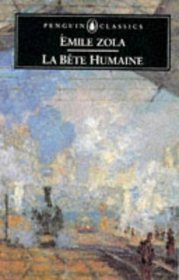A must read for lovers of the classics.
One of Zola's most violent and pessimistic novels, this book is haunted by the idea that
"love and death, possessing and killing, are the dark foundations of the human soul."
"love and death, possessing and killing, are the dark foundations of the human soul."
I first became interested in Emile Zola after seeing the 1937 movie The Life of Emile Zola in high school. The film starred Paul Muni as the French author and was set in the mid through late 19th century, depicting Zola's early friendship with Post-Impressionist painter Paul Cézanne and his rise to fame through his prolific writing. It also explores his involvement late in the Dreyfus affair. I enjoyed this movie and it was one that stuck with me over the years. Since then, I have read several of Zola's works including Nana, Therese Raquin, L'Assommoir, and Germinal. I thought all of these novels were excellent showing life in 19th century France from the point of view of Zola's naturalistic writing.
La Bête Humaine was the 17th novel in Zola's series Les Rougons-Macquart, which he sought to follow the effects of heredity and environment on a single family. The novel focuses on the French railway along with the violent passions of men. The main protagonist of the novel is Jacques Lantier who Zola describes as the third son of Gervaise and Lantier from the novel L'Assommoir. Jacques is a train driver tormented by a pathological desire to kill women. Later generations would describe Jacques as a serial killer. Another character in the story is Roubaud, the station master of the Le Havre train station. Roubaud is married to a beautiful young wife, Severine, who was abused by the company president when she was only 16. When Roubaud finds this out, his jealousy turns him into a beast and he ends up killing the president with the help of Severine. This act was witnessed by Lantier which is a catalyst making his desire to kill even greater. This all leads to some very deadly consequences for all the parties involved.
This novel is one of Zola's most violent and passionate works. I would rank it very high among his novels I have read maybe second only to Germinal. His descriptions of the railroad and its workings were excellent while the violence in the novel comes at you without a lot of warning. This novel was also made into a 1938 French film directed by Jean Renoir. I remember seeing this several years ago on Turner Classic Movies and this was also a motivation to read the book which I am glad I finally got around to.
La Bête Humaine was the 17th novel in Zola's series Les Rougons-Macquart, which he sought to follow the effects of heredity and environment on a single family. The novel focuses on the French railway along with the violent passions of men. The main protagonist of the novel is Jacques Lantier who Zola describes as the third son of Gervaise and Lantier from the novel L'Assommoir. Jacques is a train driver tormented by a pathological desire to kill women. Later generations would describe Jacques as a serial killer. Another character in the story is Roubaud, the station master of the Le Havre train station. Roubaud is married to a beautiful young wife, Severine, who was abused by the company president when she was only 16. When Roubaud finds this out, his jealousy turns him into a beast and he ends up killing the president with the help of Severine. This act was witnessed by Lantier which is a catalyst making his desire to kill even greater. This all leads to some very deadly consequences for all the parties involved.
This novel is one of Zola's most violent and passionate works. I would rank it very high among his novels I have read maybe second only to Germinal. His descriptions of the railroad and its workings were excellent while the violence in the novel comes at you without a lot of warning. This novel was also made into a 1938 French film directed by Jean Renoir. I remember seeing this several years ago on Turner Classic Movies and this was also a motivation to read the book which I am glad I finally got around to.




